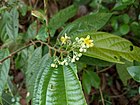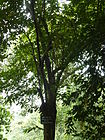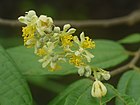Note: This is a project under development. The articles on this wiki are just being initiated and broadly incomplete. You can Help creating new pages.
Difference between revisions of "Microcos paniculata"
(Created page with "{{stub}} ==Uses== {{Uses|}}, {{Uses|}}, {{Uses|}}, {{Uses|}}, {{Uses|}}, {{Uses|}}, {{Uses|}}, {{Uses|}}, {{Uses|}}, {{Uses|}}, {{Uses|}}.<ref name="Uses"/> ==Parts Used== {{...") |
(→References) |
||
| (7 intermediate revisions by 2 users not shown) | |||
| Line 1: | Line 1: | ||
| − | + | [[File:Microcos paniculata- Microcos, Kottakka.jpg|thumb|right|''Microcos paniculata'']] | |
| + | '''Microcos paniculata''' is a flowering shrub native to China and south-east Asia. It is sometimes added to Chinese herbal tea, having a mildly sour taste. In traditional Chinese medicine the plant is believed to help the digestive system. | ||
==Uses== | ==Uses== | ||
| − | {{Uses|}}, {{Uses|}}, {{Uses|}}, {{Uses|}}, {{Uses|}}, {{Uses|}} | + | {{Uses|Colds}}, {{Uses|Hepatitis}}, {{Uses|Hepatitis}}, {{Uses|Diarrhea}}, {{Uses|Heat stroke}}, {{Uses|Dyspepsia}}. |
| + | |||
| + | ===Food=== | ||
| + | Microcos paniculata can be used in Food. Ripe fruits are eaten raw<ref name="Forest foods of Western Ghat"/>. | ||
==Parts Used== | ==Parts Used== | ||
| − | {{Parts Used|}}, {{Parts Used| | + | {{Parts Used|Leaves}}, {{Parts Used|Fruits}}. |
==Chemical Composition== | ==Chemical Composition== | ||
| − | <ref name="chemical composition"/> | + | The stem bark of Microcos paniculata contained a new alkaloid, N-Methyl-6 beta-(deca-1',3',5'-trienyl)-3 beta-methoxy-2 beta-methylpiperidine, which showed good insecticidal activity against Aedes aegypti second instar larvae.<ref name="chemical composition"/> |
==Common names== | ==Common names== | ||
| − | {{Common names | + | {{Common names|kn=|ml=|sa=|ta=|te=|hi=Pahari Pudina|en=Spearmint, Garden mint, Lamb mint}} |
==Properties== | ==Properties== | ||
Reference: Dravya - Substance, Rasa - Taste, Guna - Qualities, Veerya - Potency, Vipaka - Post-digesion effect, Karma - Pharmacological activity, Prabhava - Therepeutics. | Reference: Dravya - Substance, Rasa - Taste, Guna - Qualities, Veerya - Potency, Vipaka - Post-digesion effect, Karma - Pharmacological activity, Prabhava - Therepeutics. | ||
===Dravya=== | ===Dravya=== | ||
| + | |||
===Rasa=== | ===Rasa=== | ||
| − | |||
===Guna=== | ===Guna=== | ||
| − | |||
===Veerya=== | ===Veerya=== | ||
| Line 27: | Line 30: | ||
===Prabhava=== | ===Prabhava=== | ||
| + | |||
| + | ===Nutritional components=== | ||
| + | Microcos paniculata Contains the Following nutritional components like - Triterpens, fl avanoids and anthocynin<ref name="Forest foods of Western Ghat"/>. | ||
==Habit== | ==Habit== | ||
| − | {{Habit|}} | + | {{Habit|Tree}} |
==Identification== | ==Identification== | ||
===Leaf=== | ===Leaf=== | ||
| − | {{Leaf|||}}<ref name="Leaf"/> | + | {{Leaf|Simple| Leaves 3-costate, elliptic-lanceolate or ovate-lanceolate|8.5-13.5 cm long, 4-5.5 cm broad glabrous except for stellate hairs on veins and veinlets beneath, entire or slightly serrate.}}<ref name="Leaf"/> |
===Flower=== | ===Flower=== | ||
| − | {{Flower||| | + | {{Flower|Unisexual|8-15 cm long|Yellowish-white||8-10 mm across; pedicels small, hairy; bracts subulate, c. 3-4 mm long, caducous. Sepals linear-oblong, 6-7 mm long, 2.5-3 mm broad, densely hairy outside, cucullate at the apex.}} |
| − | |||
| − | |||
| − | |||
===Other features=== | ===Other features=== | ||
| Line 46: | Line 49: | ||
==Where to get the saplings== | ==Where to get the saplings== | ||
| − | |||
==Mode of Propagation== | ==Mode of Propagation== | ||
| − | {{Propagation|}} | + | {{Propagation|Seeds}}. |
==How to plant/cultivate== | ==How to plant/cultivate== | ||
| − | <ref name=" | + | Microcos paniculata is available through June- November<ref name="Forest foods of Western Ghat"/>. |
==Commonly seen growing in areas== | ==Commonly seen growing in areas== | ||
| − | {{Commonly seen|}}, {{Commonly seen|}}, {{Commonly seen| | + | {{Commonly seen|Eastern Bengal}}, {{Commonly seen|Khasia mountains}}, {{Commonly seen|Shrub in undergrowth of moist deciduous forest}}. |
==Photo Gallery== | ==Photo Gallery== | ||
<gallery class="left" caption="" widths="140px" heights="140px"> | <gallery class="left" caption="" widths="140px" heights="140px"> | ||
| − | + | File:Microcos paniculata- Microcos, Kottakka 2.jpg | |
| + | File:Microcos paniculata.JPG | ||
| + | File:Microcos paniculata (4801892357).jpg | ||
| + | File:Microcos (5852209813).jpg | ||
</gallery> | </gallery> | ||
==References== | ==References== | ||
<references> | <references> | ||
| − | + | <ref name="chemical composition">[https://www.researchgate.net/publication/12471135_Insecticidal_piperidine_alkaloid_from_Microcos_paniculata_stem_bark Sciencedirect]</ref> | |
| − | <ref name="chemical composition">[ | + | <ref name="Leaf">[http://www.flowersofindia.net/catalog/slides/Shiral.html Botonomy]</ref> |
| − | + | <ref name="Forest foods of Western Ghat">"Forest food for Northern region of Western Ghats" by Dr. Mandar N. Datar and Dr. Anuradha S. Upadhye, Page No.87, Published by Maharashtra Association for the Cultivation of Science (MACS) Agharkar Research Institute, Gopal Ganesh Agarkar Road, Pune</ref> | |
| − | <ref name="Leaf">[ | ||
| − | |||
| − | <ref name=" | ||
| − | |||
</references> | </references> | ||
==External Links== | ==External Links== | ||
| − | * [ ] | + | * [http://www.flowersofindia.net/catalog/slides/Shiral.html Microcos paniculata] |
| − | + | ||
| − | |||
[[Category:Herbs]] | [[Category:Herbs]] | ||
| + | [[Category:Tiliaceae]] | ||
Latest revision as of 11:25, 1 November 2021
Microcos paniculata is a flowering shrub native to China and south-east Asia. It is sometimes added to Chinese herbal tea, having a mildly sour taste. In traditional Chinese medicine the plant is believed to help the digestive system.
Contents
- 1 Uses
- 2 Parts Used
- 3 Chemical Composition
- 4 Common names
- 5 Properties
- 6 Habit
- 7 Identification
- 8 List of Ayurvedic medicine in which the herb is used
- 9 Where to get the saplings
- 10 Mode of Propagation
- 11 How to plant/cultivate
- 12 Commonly seen growing in areas
- 13 Photo Gallery
- 14 References
- 15 External Links
Uses
Colds, Hepatitis, Hepatitis, Diarrhea, Heat stroke, Dyspepsia.
Food
Microcos paniculata can be used in Food. Ripe fruits are eaten raw[1].
Parts Used
Chemical Composition
The stem bark of Microcos paniculata contained a new alkaloid, N-Methyl-6 beta-(deca-1',3',5'-trienyl)-3 beta-methoxy-2 beta-methylpiperidine, which showed good insecticidal activity against Aedes aegypti second instar larvae.[2]
Common names
| Language | Common name |
|---|---|
| Kannada | |
| Hindi | Pahari Pudina |
| Malayalam | |
| Tamil | |
| Telugu | |
| Marathi | NA |
| Gujarathi | NA |
| Punjabi | NA |
| Kashmiri | NA |
| Sanskrit | |
| English | Spearmint, Garden mint, Lamb mint |
Properties
Reference: Dravya - Substance, Rasa - Taste, Guna - Qualities, Veerya - Potency, Vipaka - Post-digesion effect, Karma - Pharmacological activity, Prabhava - Therepeutics.
Dravya
Rasa
Guna
Veerya
Vipaka
Karma
Prabhava
Nutritional components
Microcos paniculata Contains the Following nutritional components like - Triterpens, fl avanoids and anthocynin[1].
Habit
Identification
Leaf
| Kind | Shape | Feature |
|---|---|---|
| Simple | Leaves 3-costate, elliptic-lanceolate or ovate-lanceolate | 8.5-13.5 cm long, 4-5.5 cm broad glabrous except for stellate hairs on veins and veinlets beneath, entire or slightly serrate. |
Flower
| Type | Size | Color and composition | Stamen | More information |
|---|---|---|---|---|
| Unisexual | 8-15 cm long | Yellowish-white | 8-10 mm across; pedicels small, hairy; bracts subulate, c. 3-4 mm long, caducous. Sepals linear-oblong, 6-7 mm long, 2.5-3 mm broad, densely hairy outside, cucullate at the apex. |
Other features
List of Ayurvedic medicine in which the herb is used
Where to get the saplings
Mode of Propagation
How to plant/cultivate
Microcos paniculata is available through June- November[1].
Commonly seen growing in areas
Eastern Bengal, Khasia mountains, Shrub in undergrowth of moist deciduous forest.
Photo Gallery
References
External Links
- Ayurvedic Herbs known to be helpful to treat Colds
- Ayurvedic Herbs known to be helpful to treat Hepatitis
- Ayurvedic Herbs known to be helpful to treat Diarrhea
- Ayurvedic Herbs known to be helpful to treat Heat stroke
- Ayurvedic Herbs known to be helpful to treat Dyspepsia
- Herbs with Leaves used in medicine
- Herbs with Fruits used in medicine
- Herbs with common name in Hindi
- Herbs with common name in English
- Habit - Tree
- Index of Plants which can be propagated by Seeds
- Herbs that are commonly seen in the region of Eastern Bengal
- Herbs that are commonly seen in the region of Khasia mountains
- Herbs that are commonly seen in the region of Shrub in undergrowth of moist deciduous forest
- Herbs
- Tiliaceae




